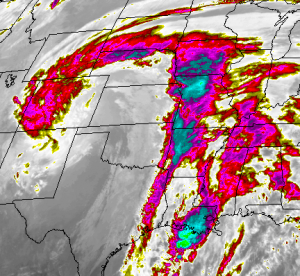Where to publish case studies in meteorology
 Dr. Alexander Keul of Salzburg University asked me whether any journals were publishing case studies in meteorology. What was interesting was that I had received another question or two along these lines recently. Seemed like an opportunity to blog.
Dr. Alexander Keul of Salzburg University asked me whether any journals were publishing case studies in meteorology. What was interesting was that I had received another question or two along these lines recently. Seemed like an opportunity to blog.
I would argue that there are two extremes of what one might call “case studies.”
On the one extreme is what we might call a scientific case study. A scientific case study would be a description of a weather event that reveals how to improve weather forecasting or something new about the science of meteorology.
On the other extreme is what we might call a descriptive case study. A descriptive case study is a description of a weather event with no insight into how to improve weather forecasting or no new scientific knowledge.
In between these two extremes are all kinds of case studies with varying degrees of new scientific knowledge or forecasting insight.
Quite a few journals will publish scientific case studies: Monthly Weather Review, Weather and Forecasting, QJRMS, and the Electronic Journal for Severe Storms Meteorology (EJSSM), for example. All of these are available online, and EJSSM is open access, as well (although not ISI ranked). Only a few journals that I am aware of publish descriptive case studies. International Journal of Meteorology and Weather magazine, published by the Royal Meteorological Society, are two I can think of. There are probably local or national journals that also publish case studies pertinent to local weather forecasters, as well. I am aware of the Romanian Journal of Meteorology that serves this purpose. None of these is ISI ranked that I am aware of.
So, the question is whether the case study has new scientific content or applicability to forecasting. To me, this is what authors considering writing up a case study should aim for. To write up a descriptive case study isn’t useful to too many people, except perhaps those who want to relive the event or read about hazardous weather in other parts of the world. Many descriptive case studies originate because the authors lived through the event (perhaps even busted a forecast on it) and want to figure out what happened for themselves. Although personally interesting, this is not too useful to others who want to learn how to forecast the event better next time unless the event is placed in some context.
So, the question that many journals are asking is whether this case study is a new and original contribution to the literature. Does authors’ paper tell the audience something that they haven’t known before? I think this is where many authors of case studies fail in their duty to their readers. Many case studies are not much more than a description of the weather that day. Such a document would not help anyone make a better forecast or understand the weather better.
If you have seen Eloquent Science, chapter 2 tries to address this question about choosing a good scientific question upon which to base the paper. If an author can select a good question and answer it in a written document, then case studies are welcome at many journals.
The problem is three-fold.
1) No good question to base the paper around. Nothing new learned.
A case study of a devastating tornado event is not enough to get published in many journals. If your study reveals something new about tornadic storms that hasn’t been seen before in the abundant literature on tornadoes, then you may have something publishable.
2) Poor diagnosis of the event.
Unfortunately, even if there is an interesting scientific question or a possible improvement to forecasting, many authors fail in their ability to convince the readers that their ideas are correct. This may be because they don’t know how to formulate a scientific argument and present evidence to test their hypothesis. This often isn’t easy with inadequate data, inappropriate tools available, or inadequate understanding of how the atmosphere works by the meteorological community.
3) Poor description of the science and event
Even if a good scientific question is present and the author has the appropriate diagnostic tools to address the question, the author may not be able to communicate their argument effectively. They don’t have the ability to write well or present their argument in text.
For these three reasons, I think case studies have gotten a bad reputation. Too many bad case studies have been written and published, which also makes many journals reluctant to consider new case studies, even though many good case studies are published each year.
As far as MWR goes, the mission statement on the Web site does not exclude case studies.
<http://journals.ametsoc.org/loi/mwre>
“Research results relevant to the analysis and prediction of observed atmospheric circulations and physics, including technique development, data assimilation, model validation, and relevant case studies. This includes papers on numerical and data assimilation techniques that apply to the atmosphere and/or ocean environments as well as socioeconomic analyses of the impacts of weather and weather forecasts. MWR focuses on phenomena having seasonal and subseasonal time scales. Reviews of climatological aspects of high-impact events such as hurricanes, as well as review articles, are occasionally published.”
If you haven’t seen it, then this article on how to write an effective case study may be of use to you and your colleagues.
http://www.ejssm.org/ojs/index.php/ejssm/issue/view/20



I would like to add that the National Weather Association’s (NWAs) Electronic Journal of Operational Meteorology (EJOM) is another option for publishing case studies:
http://www.nwas.org/ej/index.php
The EJOM articles are shorter than most, which requires authors to really keep their paper focused.